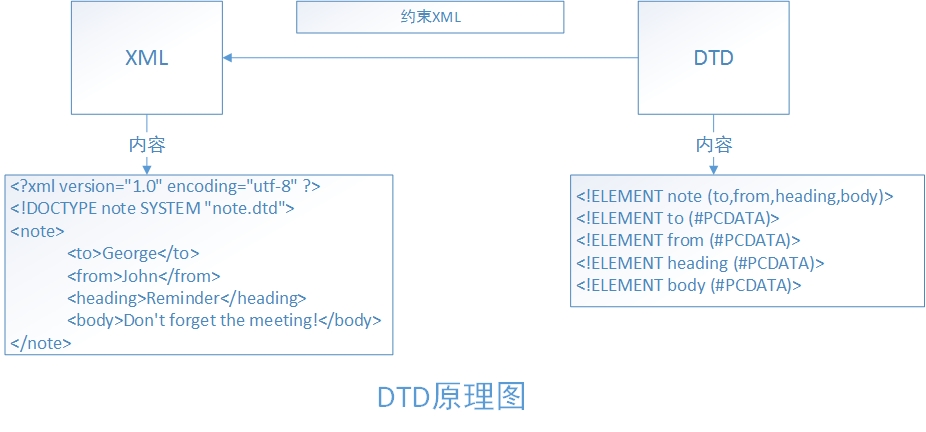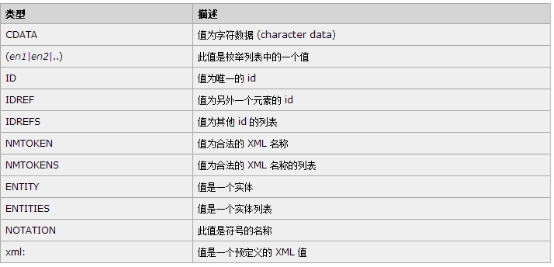Detailed explanation of DTD
DTDDetailed explanation
##Basic overview
(Document Type Definition) is a set of grammatical rules about tags established for data exchange between programs. It is part of the Standard Generalized Markup Language (SGML) and Extensible Markup Language (XML) version 1.0, and is documented under Some DTD syntax rule verifies that the format conforms to this rule. Document type definitions can also be used to ensure the legality of standard universal markup language and extensible markup language document formats. You can compare documents with document type definition files to check whether the document conforms to the specification and whether the elements and tags are used correctly. File instances provide applications with a format for exchanging data.
PS: In short, DTD is used to constrain XML document, so that it can be used under certain specifications. In addition to DTD technology, there is also Schema technology, which is also used For constrained XML documents.
Reference document:DTD http://www.php.cn/
Reference document:Schema http://www.php.cn/
DTDSchematic

PS: Constrained by DTD, XML can be customized under the constraints of DTD, but DTD has A disadvantage is that it cannot impose range constraints such as numerical constraints on the data.
DTDDeclaration and reference of document
InternalDTDDocumentation
##Root element [Definition content]>External
DTDDocument
Root element SYSTEM "DTD File path">Internal and external
DTDDocument combination
Root element SYSTEM "DTDFile path" [
Definition content
]>Note:
1
, definition keywords must be capitalized, for example:DOCTYPE, ELEMENT, ATTLIST. 2
,When the referenced file is local, the following method is used:
Document root node SYSTEM "URL of the DTD file">
For example: Bookshelf SYSTEM “book. dtd”>
When the referenced file is a public file, the following method is used:
Document root node PUBLIC "DTDname" "DTDfileURL">
##For example: "-//Sun Microsystems, Inc.//DTD Web Application 2.3//EN" "http://java.sun.com/dtd/web-app_2_3.dtd">
DTDElement
Basic GrammarExplanation: ELEMENT: Keyword
(must be capitalized).
NAME: Element name.
CONTENT: There are four element types, all of which must be capitalized.
1、EMPTY-This element cannot contain sub-elements and text, but it can have attributes (empty elements)
## 2、ANY-This element can contain anything in DTD## Element content defined in # 3
、#PCDATA-can contain any character data, but cannot It contains any sub-elements## 4, other types
(combination), can be a sub-element, a combination of sub-element and modifier, a combination of basic element, sub-element and modifier. Case:
Class
(Student+,Author)>Student
(Name,Age,Introduction)>< ;!ELEMENT Author
(#PCDATA)>Name
(#PCDATA)>Age
(#PCDATA)>Introduction
(#PCDATA)>Modifier
Use |
Example |
Example description |
|
( ) |
Used to group elements |
(古龙|Jin Yong|Liang Yusheng),(Wang Shuo|Yu Jie) |
Divided into two groups |
| | Select one of the listed objects |
(Men|Women) |
means that a man or a woman must appear, and you can only choose one |
| ##+ | The object appears at least once and can appear multiple times (1 or multiple times) |
(Member +) |
indicates that the member must appear, and multiple members can appear Member |
| * | ##This object is allowed to appear zero to any number of times (0 to many times) | (Hobby* ) | Hobby can appear zero to multiple times|
| This object can appear, But it can only appear once | (0 to 1 times) | (Rookie? ) ##The rookie can appear or not. If it appears, Can only appear once at most | |
| Objects must appear in the specified order |
(Watermelon | ,
Apple,banana) ## means watermelon, apple, banana must appear, and appear in this order |
# # ##DTD AttributesBasic Syntax##Attribute name Type Attribute attribute Attribute name Type Attribute characteristics......> Explanation: ATTLIST : attribute list, (must be capitalized ).Element name: The name of the corresponding element. Attribute: There can be multiple attributes, and the format is name type attribute property Type:
##PS : Commonly used ones areCDATA(Character type), enumeration (The enumeration format is (value1| Value2|Value3...)),ID(ID cannot be repeated and cannot start with a number ), IDREF( refers to another IDValue),IDREFS(can reference multiple ID Values, separated by spaces ) Attribute characteristics are:
Case: <!ELEMENT 班级 (学生+,作者)> <!ATTLIST 班级 班次 CDATA "1班" 编号 ID #REQUIRED > <!ELEMENT 学生 (名字,年龄,介绍)> <!ELEMENT 作者 (#PCDATA)> <!ATTLIST 学生 地址 CDATA #IMPLIED 授课方式 CDATA #FIXED "面授" 学号 ID #REQUIRED 班级编号 IDREF #REQUIRED 朋友 IDREFS #IMPLIED > <!ELEMENT 名字 (#PCDATA)> <!ELEMENT 年龄 (#PCDATA)> <!ELEMENT 介绍 (#PCDATA)> Copy after login Entity XML, and parameter entities are generally used in DTD. Basic syntax ##Entity name"Entity content"> // Reference entity##Entity name "Entity content" > // Parameter entityExplanation: 1, the reference entity can be referenced DTD XML file, use &entity name; to use entity content. 2. I don’t know if it’s because of my computer. You can’t use reference entities in external DTD . If you use it, put the reference entity definition in In the internal DTD, it can be used. 3, parameter entity is used in DTD , use %entity name;use 4、可以将那些重复使用的值定义成实体,这样能减少代码的冗余度。 5、在外部DTD中,引用实体最好放在DTD底部,参数实体最好放在DTD顶部。
案例: <!ENTITY % sex "男|女"> <!ELEMENT 班级 (学生+,作者)> <!ELEMENT 学生 (名字,年龄,介绍)> <!ELEMENT 作者 (#PCDATA)> <!ATTLIST 学生 性别 (%sex;) #REQUIRED > <!ELEMENT 名字 (#PCDATA)> <!ELEMENT 年龄 (#PCDATA)> <!ELEMENT 介绍 (#PCDATA)> <!ENTITY writer "Switch"> Copy after login 综合案例1: XML3.dtd <!ENTITY % sex "男|女"> <!ELEMENT 班级 (学生+,作者)> <!ATTLIST 班级 班次 CDATA "1班" 编号 ID #REQUIRED > <!ELEMENT 学生 (名字,年龄,介绍)> <!ELEMENT 作者 (#PCDATA)> <!ATTLIST 学生 地址 CDATA #IMPLIED 授课方式 CDATA #FIXED "面授" 学号 ID #REQUIRED 班级编号 IDREF #REQUIRED 朋友 IDREFS #IMPLIED 性别 (%sex;) #REQUIRED > <!ELEMENT 名字 (#PCDATA)> <!ELEMENT 年龄 (#PCDATA)> <!ELEMENT 介绍 (#PCDATA)> Copy after login XML3.xml <?xml version="1.0" encoding="UTF-8"?> <!-- 引入DTD --> <!DOCTYPE 班级 SYSTEM "XML3.dtd" [<!ENTITY writer "Switch">]> <班级 编号="C1" 班次="1班"> <学生 地址="湖南" 授课方式="面授" 学号="n1" 班级编号="C1" 朋友="n2" 性别="男"> <名字>张三</名字> <年龄>20</年龄> <介绍>不错</介绍> </学生> <学生 授课方式="面授" 学号="n2" 班级编号="C1" 朋友="n1 n3" 性别="女"> <名字>李四</名字> <年龄>18</年龄> <介绍>很好</介绍> </学生> <学生 授课方式="面授" 学号="n3" 班级编号="C1" 朋友="n2" 性别="男"> <名字>王五</名字> <年龄>22</年龄> <介绍>非常好</介绍> </学生> <作者>&writer;</作者> </班级> Copy after login 综合案例2: XML4.dtd <!ENTITY AUTHOR "John Doe"> <!ENTITY COMPANY "JD Power Tools, Inc."> <!ENTITY EMAIL "jd@jd-tools.com"> <!ELEMENT CATALOG (PRODUCT+)> <!ELEMENT PRODUCT (SPECIFICATIONS+,OPTIONS?,PRICE+,NOTES?)> <!ATTLIST PRODUCT NAME CDATA #IMPLIED CATEGORY (HandTool|Table|Shop-Professional) "HandTool" PARTNUM CDATA #IMPLIED PLANT (Pittsburgh|Milwaukee|Chicago) "Chicago" INVENTORY (InStock|Backordered|Discontinued) "InStock"> <!ELEMENT SPECIFICATIONS (#PCDATA)> <!ATTLIST SPECIFICATIONS WEIGHT CDATA #IMPLIED POWER CDATA #IMPLIED> <!ELEMENT OPTIONS (#PCDATA)> <!ATTLIST OPTIONS FINISH (Metal|Polished|Matte) "Matte" ADAPTER (Included|Optional|NotApplicable) "Included" CASE (HardShell|Soft|NotApplicable) "HardShell"> <!ELEMENT PRICE (#PCDATA)> <!ATTLIST PRICE MSRP CDATA #IMPLIED WHOLESALE CDATA #IMPLIED STREET CDATA #IMPLIED SHIPPING CDATA #IMPLIED> <!ELEMENT NOTES (#PCDATA)> Copy after login XML4.xml <?xml version="1.0" encoding="UTF-8"?> <!DOCTYPE CATALOG SYSTEM "XML4.dtd"> <CATALOG> <PRODUCT NAME="C'estbon" CATEGORY="Shop-Professional" INVENTORY="Backordered" PARTNUM="10" PLANT="Chicago"> <SPECIFICATIONS POWER="0" WEIGHT="555ml">SPECIFICATIONS</SPECIFICATIONS> <OPTIONS>OPTIONS</OPTIONS> <PRICE>2</PRICE> <NOTES>NOTES</NOTES> </PRODUCT> </CATALOG> Copy after login 以上就是DTD详解的内容,更多相关内容请关注PHP中文网(www.php.cn)! |

Hot AI Tools

Undresser.AI Undress
AI-powered app for creating realistic nude photos

AI Clothes Remover
Online AI tool for removing clothes from photos.

Undress AI Tool
Undress images for free

Clothoff.io
AI clothes remover

Video Face Swap
Swap faces in any video effortlessly with our completely free AI face swap tool!

Hot Article

Hot Tools

Notepad++7.3.1
Easy-to-use and free code editor

SublimeText3 Chinese version
Chinese version, very easy to use

Zend Studio 13.0.1
Powerful PHP integrated development environment

Dreamweaver CS6
Visual web development tools

SublimeText3 Mac version
God-level code editing software (SublimeText3)

Hot Topics
 1386
1386
 52
52
 Is the conversion speed fast when converting XML to PDF on mobile phone?
Apr 02, 2025 pm 10:09 PM
Is the conversion speed fast when converting XML to PDF on mobile phone?
Apr 02, 2025 pm 10:09 PM
The speed of mobile XML to PDF depends on the following factors: the complexity of XML structure. Mobile hardware configuration conversion method (library, algorithm) code quality optimization methods (select efficient libraries, optimize algorithms, cache data, and utilize multi-threading). Overall, there is no absolute answer and it needs to be optimized according to the specific situation.
 How to convert XML files to PDF on your phone?
Apr 02, 2025 pm 10:12 PM
How to convert XML files to PDF on your phone?
Apr 02, 2025 pm 10:12 PM
It is impossible to complete XML to PDF conversion directly on your phone with a single application. It is necessary to use cloud services, which can be achieved through two steps: 1. Convert XML to PDF in the cloud, 2. Access or download the converted PDF file on the mobile phone.
 How to convert XML to PDF on your phone?
Apr 02, 2025 pm 10:18 PM
How to convert XML to PDF on your phone?
Apr 02, 2025 pm 10:18 PM
It is not easy to convert XML to PDF directly on your phone, but it can be achieved with the help of cloud services. It is recommended to use a lightweight mobile app to upload XML files and receive generated PDFs, and convert them with cloud APIs. Cloud APIs use serverless computing services, and choosing the right platform is crucial. Complexity, error handling, security, and optimization strategies need to be considered when handling XML parsing and PDF generation. The entire process requires the front-end app and the back-end API to work together, and it requires some understanding of a variety of technologies.
 Is there any mobile app that can convert XML into PDF?
Apr 02, 2025 pm 08:54 PM
Is there any mobile app that can convert XML into PDF?
Apr 02, 2025 pm 08:54 PM
An application that converts XML directly to PDF cannot be found because they are two fundamentally different formats. XML is used to store data, while PDF is used to display documents. To complete the transformation, you can use programming languages and libraries such as Python and ReportLab to parse XML data and generate PDF documents.
 How to open web.xml
Apr 03, 2025 am 06:51 AM
How to open web.xml
Apr 03, 2025 am 06:51 AM
To open a web.xml file, you can use the following methods: Use a text editor (such as Notepad or TextEdit) to edit commands using an integrated development environment (such as Eclipse or NetBeans) (Windows: notepad web.xml; Mac/Linux: open -a TextEdit web.xml)
 Recommended XML formatting tool
Apr 02, 2025 pm 09:03 PM
Recommended XML formatting tool
Apr 02, 2025 pm 09:03 PM
XML formatting tools can type code according to rules to improve readability and understanding. When selecting a tool, pay attention to customization capabilities, handling of special circumstances, performance and ease of use. Commonly used tool types include online tools, IDE plug-ins, and command-line tools.
 How to open xml format
Apr 02, 2025 pm 09:00 PM
How to open xml format
Apr 02, 2025 pm 09:00 PM
Use most text editors to open XML files; if you need a more intuitive tree display, you can use an XML editor, such as Oxygen XML Editor or XMLSpy; if you process XML data in a program, you need to use a programming language (such as Python) and XML libraries (such as xml.etree.ElementTree) to parse.
 How to export pdf with xml
Apr 03, 2025 am 06:45 AM
How to export pdf with xml
Apr 03, 2025 am 06:45 AM
There are two ways to export XML to PDF: using XSLT and using XML data binding libraries. XSLT: Create an XSLT stylesheet, specify the PDF format to convert XML data using the XSLT processor. XML Data binding library: Import XML Data binding library Create PDF Document object loading XML data export PDF files. Which method is better for PDF files depends on the requirements. XSLT provides flexibility, while the data binding library is simple to implement; for simple conversions, the data binding library is better, and for complex conversions, XSLT is more suitable.






